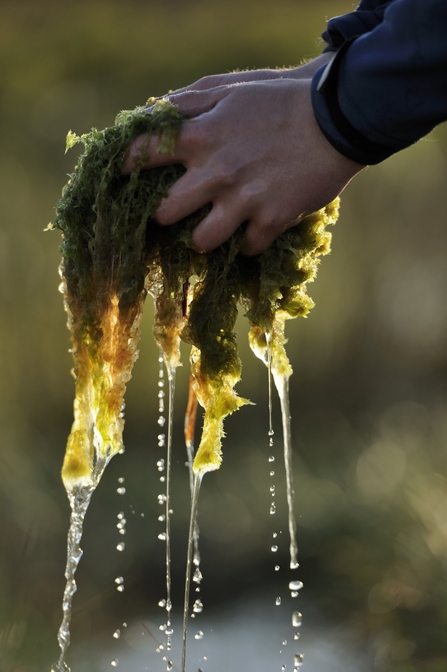In 2008 iCASP published research that showed how water running over Sphagnum on blanket peatlands moved much more slowly (often ten times slower) than water running through sedges or bare peat. This spawned a new body of research which has shown how revegetation of peat, particularly if we can get a dense Sphagnum cover, can slow the flow of water during storm events to reduce the flood peak downstream. The research indicates priority areas in the landscape for dense surface revegetation that will generally maximise flood benefits. Given that we have also recently shown sediment release from bare peat strongly influences peatland stream ecosystems this gives added impetus to revegetating peatlands and enhancing Sphagnum cover to achieve maximum downstream benefits for river habitats and flood risk.
Sphagnum is a key ingredient of natural flood management

Squeezing water out of Sphagnum moss. Credit Lorne Gill/NatureScot
Unlike most soil types where movement of water through the soil attenuates the rate of water loss into rivers, research has shown that water movement in blanket peatlands tends to be dominated by flow very close to the surface or at the surface. This means large volumes of water move over short periods of time, associated with rainfall or snowmelt, producing very high flow peaks in blanket peatland rivers compared to the flows that occur during dry weather. The condition of the peatland surface may therefore be crucial in determining the downstream flood peak during storms.
Over a decade ago we published research that showed how water running over Sphagnum on blanket peatlands moved much more slowly than water running through sedges or bare peat. This spawned a new body of research which tried to establish whether such effects made any difference to riverflow. This work, which included both empirical field demonstrations and modelling experiments, has now shown that revegetation of peat, particularly if we can get a dense Sphagnum cover, can slow the flow of water during storm events reducing the flood peak downstream. These effects hold (and can be proportionally greater) even for the very largest storm events. The research indicates priority areas for the densest revegetation in the landscape to maximise flood benefits. These areas include strips of peatland several metres wide that run either side of streams, ditches and other watercourses, and areas of peatland covering other gently sloping parts of the catchment.
We have also recently shown that sediment release from bare peat strongly influences peatland stream ecosystems affecting both their biodiversity and functioning. This shows that we need to do all we can to disconnect sediment sources from the peatland streams. The most effective way to do so is to support revegetation of peatlands, especially near any watercourses. Thus, targeted restoration work that aims to achieve an end-point with a dense Sphagnum understorey will deliver maximum downstream benefits for river habitats and flood risk, while simultaneously adding resilience to the peatland ecosystems in the face of climate change, drought and wildfire.
Joseph Holden, NERC Integrated Catchment Solutions Programme, University of Leeds
